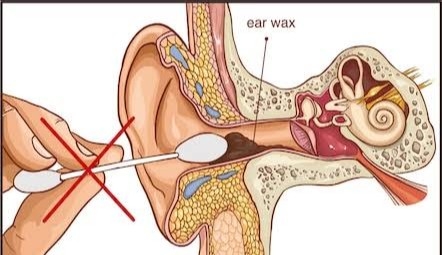profile/6114IMG_20191216_135029.jpg
Pharmyt

Earwax Blockage: Sign And Symptoms, Causes, Treatment With Home Remedies For Healthy Ear Drum.
~3.8 mins read
Earwax blockage occurs when earwax (cerumen) accumulates in your ear or becomes too hard to wash away naturally.
Earwax is a helpful and natural part of your body's defenses. It cleans, lubricates and protects your ear canal by trapping dirt and slowing the growth of bacteria.
If earwax blockage becomes a problem, you or your doctor can take simple steps to remove the wax safely.
Symptoms
Signs and symptoms of earwax blockage may include:
• Earache
• Feeling of fullness in the affected ear
• Ringing or noises in the ear (tinnitus)
• Decreased hearing in the affected ear
• Dizziness
• Cough
When to see a doctor
If you're experiencing the signs and symptoms of earwax blockage, talk to your doctor.
Signs and symptoms could indicate another condition. You may think you can deal with earwax on your own, but there's no way to know if you have excessive earwax without having someone, usually your doctor, look in your ears. Having signs and symptoms, such as earache or decreased hearing, doesn't necessarily mean you have wax buildup. It's possible you have another medical condition involving your ears that may need attention.
Wax removal is most safely done by a doctor. Your ear canal and eardrum are delicate and can be damaged easily by excess earwax. Don't try to remove earwax yourself with any device placed into your ear canal, especially if you have had ear surgery, have a hole (perforation) in your eardrum, or are having ear pain or drainage.
Children usually have their ears checked as part of any medical examination. If necessary, a doctor can remove excess earwax from your child's ear during an office visit.
Causes
The wax in your ears is secreted by glands in the skin that lines the outer half of your ear canals. The wax and tiny hairs in these passages trap dust and other foreign particles that could damage deeper structures, such as your eardrum.
In most people, a small amount of earwax regularly makes its way to the opening of the ear, where it's washed away or falls out as new wax is secreted to replace it. If you secrete an excessive amount of wax or if earwax isn't cleared effectively, it may build up and block your ear canal.
Earwax blockages commonly occur when people try to clean their ears on their own by placing cotton swabs or other items in their ears. This often just pushes wax deeper into the ear, rather than removing it.
If earwax buildup is a recurring problem, your doctor may recommend that you use a wax-removal medication, such as carbamide peroxide (Debrox Earwax Removal Kit, Murine Ear Wax Removal System). Because these drops can irritate the delicate skin of the eardrum and ear canal, use them only as directed.
Alternative medicine
Some people use ear candling, a technique that involves placing a lighted, hollow, cone-shaped candle into the ear, to try to remove earwax. The theory is that the heat from the flame will create a vacuum seal and the earwax will adhere to the candle.
However, ear candling is not a recommended treatment for earwax blockage. Research has found that ear candling doesn't work, and it may result in injury, such as burns, ear canal obstructions and even perforations.
Talk to your doctor before trying any alternative remedies for removing earwax.
Lifestyle and home remedies
If your eardrum doesn't contain a tube or have a hole in it, these self-care measures may help you remove excess earwax that's blocking your ear canal:
• Soften the wax. Use an eyedropper to apply a few drops of baby oil, mineral oil, glycerin or hydrogen peroxide in your ear canal.
• Use warm water. After a day or two, when the wax is softened, use a rubber-bulb syringe to gently squirt warm water into your ear canal. Tilt your head and pull your outer ear up and back to straighten your ear canal. When finished irrigating, tip your head to the side to let the water drain out.
• Dry your ear canal. When finished, gently dry your outer ear with a towel or hand-held dryer.
You may need to repeat this wax-softening and irrigation procedure a few times before the excess earwax falls out. However, the softening agents may only loosen the outer layer of the wax and cause it to lodge deeper in the ear canal or against the eardrum. If your symptoms don't improve after a few treatments, see your doctor.
Earwax removal kits available in stores also can be effective at removing wax buildup. Ask your doctor for advice on how to properly select and use alternative earwax removal methods.
Don't try to dig it out
Never attempt to dig out excessive or hardened earwax with available items, such as a paper clip, a cotton swab or a hairpin. You may push the wax farther into your ear and cause serious damage to the lining of your ear canal or eardrum.
What you can do in the meantime
Don't attempt to dig out earwax with cotton swabs or other items — such as hairpins or pen caps. This can push the wax farther into the ear and cause serious injury to the ear canal or eardrum.
profile/6114IMG_20191216_135029.jpg
Pharmyt

Pregnancy And Arthritis: What You Need To Know About Dangerous Arthritis Medications During Pregnancy.
~1.9 mins read
Rheumatoid arthritis medications: Dangerous during pregnancy?
Many types of rheumatoid arthritis medications can harm your developing child during pregnancy. Talk to your rheumatologist and an obstetrician before you become pregnant. It's best to avoid certain rheumatoid arthritis medications for several months before you conceive.
Rheumatoid arthritis occurs when your body's immune system mistakenly begins to attack the tissues around your joints. Many rheumatoid arthritis medications work by suppressing your immune system.
Other commonly prescribed drugs control inflammation.
Different types of drugs carry different risks. Some can produce birth defects, while others can cause miscarriage. Some drugs used for rheumatoid arthritis can increase the risk of high blood pressure or diabetes for pregnant women.
The timing of when drugs are taken during the pregnancy also can be important. For example, some medications can cause problems only in the first or third trimester, while others should be avoided completely.
Prednisone use during the first trimester has been associated with cleft palate and cleft lip. However, it's often used during pregnancy in low doses for short periods.
Nonsteroidal anti-inflammatory drugs, such as ibuprofen and naproxen sodium used early in pregnancy have been associated with miscarriage in some studies. Used during the third trimester, there's a risk of developing heart problems.
Rheumatoid arthritis medications to avoid during pregnancy and breast-feeding include:
• Methotrexate - One of the most commonly used medications to treat rheumatoid arthritis, methotrexate should be stopped three months before trying to get pregnant. It can induce miscarriage early in pregnancy. Taken later in pregnancy, it can cause birth defects affecting the brain and bones.
• Leflunomide. Doctors recommend avoiding this drug even before conception because it can remain in the body for a long time. Taking cholestyramine can help speed the elimination of leflunomide from your body.
• Biologic response modifiers. Because there's limited information about the safety of this class of this Drugs during pregnancy, speak with your doctors if you're taking anakinra, Abatacept tocilizumab or tofacitinib
It's important for women who are taking these types of medications to use contraception. If you're planning to become pregnant, talk to your doctor about switching to different types of rheumatoid arthritis medications that are considered relatively safe to use during pregnancy.
Certolizumab pegol a tumor necrosis factor inhibitor, has a low risk of crossing the placenta and shows up minimally in breast milk.
More studies are needed to assess the safety of these medications during pregnancy.
For more health tips: kindly follow my page to re-quip you with health related articles and don't hesitate to like, share and comments.
Advertisement

Link socials
Matches
Loading...
